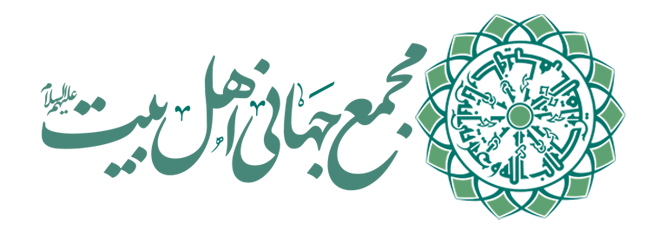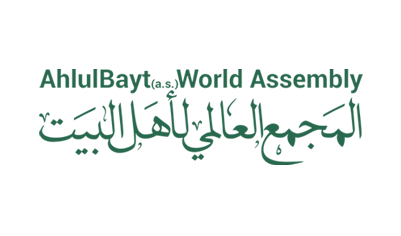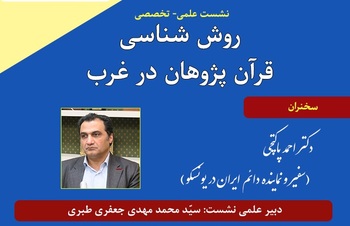Meeting on “Methodology of Quran-Researchers in the West” held at AhlulBayt (a.s.) University
On Monday morning, March 14, 2022, the meeting on “Methodology of Quran-Researchers in the West” was held by AhlulBayt (a.s.) International University with a speech by Ahmad Paktachi, Ambassador and Permanent Representative of Iran to UNESCO.
On Monday morning, March 14, 2022, the meeting on “Methodology of Quran-Researchers in the West” was held by AhlulBayt (a.s.) International University with a speech by Ahmad Paktachi, Ambassador and Permanent Representative of Iran to UNESCO.
The following is an excerpt from Paktchi’s presentation:
I am going to have a discussion on the methodology of Orientalists and Western scholars in the field of Quranic studies and Quranic research. There was no insistence that Quran-Researchers be non-Muslims, but I left Muslim Quran-Researchers out of my work schedule, trying to focus on figures who are literally Western.
The next point is that in the field of Quranic studies, I focused on ideas and thoughts that are directly related to the text of the Quran. Therefore, I excluded Western studies in the field of translation and interpretation of the Quran from my agenda, as well as studies written about the life of the Prophet Muhammad (p.b.u.h) and the events of the beginning of Islam.
Although the West covers a wide range, there are some very prominent ideas in the Western thinking space, and I have tried to look at these very thoughts more closely and I neither want to go into old discussions, nor tell history. There are three main streams that seem to be present and active. One of them is the reviewers that are mostly in North America. The second group is the followers of the “Quranic figure”, which is mostly in Germany, and rhe third stream is the stream of Quranic historians, which you see mostly in France.
Discussing that there are several main approaches in the field of Quranic studies, we can say that in the field of research methods, we are faced with three important approaches. That is, historical, analytical and comparative approaches are seen in the field of Quranic research. But their weight is not equal. For example, the weight of the historical approach is much heavier than other approaches. Therefore, I start the discussion with the historical approach to the Quran.
In the field of historical approach, in order to reach classification, some studies are mostly in the field of history of the text of the Quran. That is, this field of study looks at the text of the Quran historically and tries to examine the stages of formation of this text. The research version is another spectrum of these studies. The study of reciting, which has its roots in our Quranic sciences, is another part of these studies. Also, there is a more limited field of study that examines texts in the context of revelation. Some Quranic scholars have sought the culture of the context of revelation, and what is the connection between the Quran and the common culture of the Arabian Peninsula. Finally, the historical-critical approach that is more considered in cyberspace.
History of Critical-Historical Studies on the Quran
The historical-critical approach, while one of the most active and vivid approaches in Quranic research, has a long history. The history of this approach goes back to a field of study called “Bible Criticism”. This thought led to the creation of academic circles and scholars who sought to develop knowledge the subject of which was criticizing the Bible. They have divided bible critique into upper critique and lower critique. In the upper critique, the main issue was the identity and attribution of the various scriptures of the Bible, and for example whether The Book of Isaiah belonged to a prophet named Isaiah. The lower critique was a critique that did not discuss the principle of attribution, but rather dealt with critical in-text critical issues. This practice was later applied in the case of the Quranic studies. When an Orientalist conducts studies in the field of differntt recitation, he is involved in lower critique, and when the issue of the belonging of Quran to the Arabian Peninsula is examined, it is a upper critique. Therefore, the tradition that has emerged in the field of the critique of the Testaments has been the complete basis for Orientalists to study the Quran, and what we see as a historical-critical approach and its emergence in the Quran of historians is a continuation of this path, that how the methods of the study of the Testaments can be applied to the Quran, and the Quran is studied from this perspective.
In the book “Quran Historians” edited by Amirmoezi and Guillaume Dye, we see a wide range of achievements of dozens of Western scholars who have looked at different aspects of the Quran with a critical historical approach. Parts of this book are from the upper critique and parts are from the lower critique.
Continuation of the study of the layers of Quran
One of the types of Bible study that has been considered since the eighteenth century is a type of study called the study of layers. That is, we examine a text and show what parts this text has and what different layers were combined to create this text. A clear example of the study of layers is the study of the Five Torah Journeys. Experts of biblical critiques separated the two layers in the text of the Five Torah Journeys, saying that the two layers are independent of each other and are combined. Similar questions were asked about the book of Isaiah. There have been similar questions about the Quran over the last century and a half. Some of the information in Islamic books, such as the discussion of the division of Quranic chapters into Meccan and Madani, or the study of the reasons for the revelation of verses, helped Western Quran researchers to have a layer-study view of the Quran, and believe that the Quran consists of a Meccan layer that later a Madani layer is added to it.
This view, with the layer-studying approach, has been continued in later periods. But for now, Western Quran researchers are not concerned with studying the layers in the traditional sense, and it can be said that Western scholars feel that attempts to pursue at this kind of study of layers do not work for the Quran. They mostly ask questions about the coherence and incoherence of the Quran, and both views have proponents.
In addition to studying layers, the historical-critical approach includes another topic called source search and root search, which means examining a text to obtain its pretexts. That is, to show what previous texts have been used in the present text. The Quran's use of previous texts is intolerable and unbelievable for a Muslim. Because, according to Muslims, the Quran has a revelatory origin, and if there are similarities between the contents of the Quran and the Torah and the Bible, it is because of their commonality in revelation. But, an Orientalist who does not believe in the authenticity of the Quran does not have such sensitivity. Therefore, we see that since the eighteenth century, Orientalists have claimed and tried to show that the Prophet of Islam took information from previous Jewish and Christian texts and used it.
“Revision Approach” followers
In addition to the historical-critical perspective, I must draw the audience’s attention to the path that emerged in the Anglo-Saxon space; A movement whose followers are referred to as the “Revision Approach” followers. A common feature among the followers of this movement is that they are extremely pessimistic about Islamic hadiths and historical narrations and do not consider these narrations to be reliable. They consider these narrations as a model of the history of salvation and believe that pretense has taken place in these narrations, and the Quranic expressions should not be understood using the early hadiths of Islam. They rather believe that the Quranic expressions must be understood independently of Islamic hadiths and narrations. If a researcher looks at things independently, he may have serious questions.
Another type of historical-critical study is one that can be included in the lower critique. That is, those whose purpose is not to examine attribution, but to examine whether or not there have been any changes to the text they have.
On Monday morning, March 14, 2022, the meeting on “Methodology of Quran-Researchers in the West” was held by AhlulBayt (a.s.) International University with a speech by Ahmad Paktachi, Ambassador and Permanent Representative of Iran to UNESCO.
On Monday morning, March 14, 2022, the meeting on “Methodology of Quran-Researchers in the West” was held by AhlulBayt (a.s.) International University with a speech by Ahmad Paktachi, Ambassador and Permanent Representative of Iran to UNESCO.
The following is an excerpt from Paktchi’s presentation:
I am going to have a discussion on the methodology of Orientalists and Western scholars in the field of Quranic studies and Quranic research. There was no insistence that Quran-Researchers be non-Muslims, but I left Muslim Quran-Researchers out of my work schedule, trying to focus on figures who are literally Western.
The next point is that in the field of Quranic studies, I focused on ideas and thoughts that are directly related to the text of the Quran. Therefore, I excluded Western studies in the field of translation and interpretation of the Quran from my agenda, as well as studies written about the life of the Prophet Muhammad (p.b.u.h) and the events of the beginning of Islam.
Although the West covers a wide range, there are some very prominent ideas in the Western thinking space, and I have tried to look at these very thoughts more closely and I neither want to go into old discussions, nor tell history. There are three main streams that seem to be present and active. One of them is the reviewers that are mostly in North America. The second group is the followers of the “Quranic figure”, which is mostly in Germany, and rhe third stream is the stream of Quranic historians, which you see mostly in France.
Discussing that there are several main approaches in the field of Quranic studies, we can say that in the field of research methods, we are faced with three important approaches. That is, historical, analytical and comparative approaches are seen in the field of Quranic research. But their weight is not equal. For example, the weight of the historical approach is much heavier than other approaches. Therefore, I start the discussion with the historical approach to the Quran.
In the field of historical approach, in order to reach classification, some studies are mostly in the field of history of the text of the Quran. That is, this field of study looks at the text of the Quran historically and tries to examine the stages of formation of this text. The research version is another spectrum of these studies. The study of reciting, which has its roots in our Quranic sciences, is another part of these studies. Also, there is a more limited field of study that examines texts in the context of revelation. Some Quranic scholars have sought the culture of the context of revelation, and what is the connection between the Quran and the common culture of the Arabian Peninsula. Finally, the historical-critical approach that is more considered in cyberspace.
History of Critical-Historical Studies on the Quran
The historical-critical approach, while one of the most active and vivid approaches in Quranic research, has a long history. The history of this approach goes back to a field of study called “Bible Criticism”. This thought led to the creation of academic circles and scholars who sought to develop knowledge the subject of which was criticizing the Bible. They have divided bible critique into upper critique and lower critique. In the upper critique, the main issue was the identity and attribution of the various scriptures of the Bible, and for example whether The Book of Isaiah belonged to a prophet named Isaiah. The lower critique was a critique that did not discuss the principle of attribution, but rather dealt with critical in-text critical issues. This practice was later applied in the case of the Quranic studies. When an Orientalist conducts studies in the field of differntt recitation, he is involved in lower critique, and when the issue of the belonging of Quran to the Arabian Peninsula is examined, it is a upper critique. Therefore, the tradition that has emerged in the field of the critique of the Testaments has been the complete basis for Orientalists to study the Quran, and what we see as a historical-critical approach and its emergence in the Quran of historians is a continuation of this path, that how the methods of the study of the Testaments can be applied to the Quran, and the Quran is studied from this perspective.
In the book “Quran Historians” edited by Amirmoezi and Guillaume Dye, we see a wide range of achievements of dozens of Western scholars who have looked at different aspects of the Quran with a critical historical approach. Parts of this book are from the upper critique and parts are from the lower critique.
Continuation of the study of the layers of Quran
One of the types of Bible study that has been considered since the eighteenth century is a type of study called the study of layers. That is, we examine a text and show what parts this text has and what different layers were combined to create this text. A clear example of the study of layers is the study of the Five Torah Journeys. Experts of biblical critiques separated the two layers in the text of the Five Torah Journeys, saying that the two layers are independent of each other and are combined. Similar questions were asked about the book of Isaiah. There have been similar questions about the Quran over the last century and a half. Some of the information in Islamic books, such as the discussion of the division of Quranic chapters into Meccan and Madani, or the study of the reasons for the revelation of verses, helped Western Quran researchers to have a layer-study view of the Quran, and believe that the Quran consists of a Meccan layer that later a Madani layer is added to it.
This view, with the layer-studying approach, has been continued in later periods. But for now, Western Quran researchers are not concerned with studying the layers in the traditional sense, and it can be said that Western scholars feel that attempts to pursue at this kind of study of layers do not work for the Quran. They mostly ask questions about the coherence and incoherence of the Quran, and both views have proponents.
In addition to studying layers, the historical-critical approach includes another topic called source search and root search, which means examining a text to obtain its pretexts. That is, to show what previous texts have been used in the present text. The Quran's use of previous texts is intolerable and unbelievable for a Muslim. Because, according to Muslims, the Quran has a revelatory origin, and if there are similarities between the contents of the Quran and the Torah and the Bible, it is because of their commonality in revelation. But, an Orientalist who does not believe in the authenticity of the Quran does not have such sensitivity. Therefore, we see that since the eighteenth century, Orientalists have claimed and tried to show that the Prophet of Islam took information from previous Jewish and Christian texts and used it.
“Revision Approach” followers
In addition to the historical-critical perspective, I must draw the audience’s attention to the path that emerged in the Anglo-Saxon space; A movement whose followers are referred to as the “Revision Approach” followers. A common feature among the followers of this movement is that they are extremely pessimistic about Islamic hadiths and historical narrations and do not consider these narrations to be reliable. They consider these narrations as a model of the history of salvation and believe that pretense has taken place in these narrations, and the Quranic expressions should not be understood using the early hadiths of Islam. They rather believe that the Quranic expressions must be understood independently of Islamic hadiths and narrations. If a researcher looks at things independently, he may have serious questions.
Another type of historical-critical study is one that can be included in the lower critique. That is, those whose purpose is not to examine attribution, but to examine whether or not there have been any changes to the text they have.






